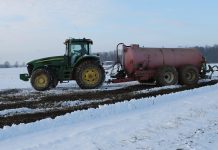The U.S. Department of Agriculture has taken the first step towards a federal order hearing by asking for additional proposals to be submitted by June 14 and a pre-hearing on June 16.
The action plan published on June 1 starts a 120-day clock that a hearing would need to be completed by. Even with this clock if a hearing is granted after the pre-hearing information session, summer of 2024 is the earliest we can hope to see changes affect milk checks. The information covered here reviews what has been proposed so far.
Part one focused on make allowance proposals, which both the International Dairy Foods Association and Wisconsin Cheese Makers Association have since submitted supplemental information for their proposals with IDFA’s showing a 4-year increase in make allowances for a gradual step-up increase instead of a large jump.
Make allowance increases have an initial negative effect on producers’ milk price but should have a long-term positive effect. While the proposals discussed this week and in part three should all have a quick positive effect on milk producer milk prices.
Changing formulas
In May 2019 Class I skim milk price mover was changed to the simple average of advanced Class III and Class IV skim milk prices plus $0.74. The goal of this change was to allow both producers and processors to better hedge milk price volatility risk.
Whenever the Class III/Class IV spread is less than $1.48/cwt the simple average pricing of Class I milk benefited dairy producers. When the spread is greater than $1.48, Class I skim milk price falls below the higher of Class III or Class IV price. The amount of Class I milk being hedged has only slightly increased, and this new formula has led to Class I milk prices falling below either Class III or Class IV when the spread is greater than $1.48.
The current proposal is to return to the higher of the advanced Class III or Class IV formula used prior to 2019. The higher of formula would have led to a higher Class I milk price during 2022-2023, 12 times with the current simple average formula being higher six times. The range in Class I skim milk price differences between these two formulas was -$2.07 to +$0.62 comparing the current simple average pricing formula minus the proposed return to higher of formula. From May 2019 through January, the simple average formula decreased the value of Class I skim milk compared to the higher of formula, creating $937.9 million dollars of lost producer revenue across the county.
Hindsight is always 20/2. In 2018 the simple average plus $0.74 formula used today would have had a higher Class I price for 10 months compared to the higher of formula that was used then. Since May 2019 we have seen big spreads between Class III and Class IV milk price which has caused these issues compared to the historic spreads.
The other issue that is created by Class I milk price falling below Class III price in federal order 33 was depooling. By shifting back to the higher of formula it will assure that shifts in manufacturing product demand does not lower Class I price. While the Class I mover change in 2019 appeared like it would be beneficial it has failed under current market conditions.
Eliminate barrel cheese
The next proposal is the elimination of 500-pound barrel cheese from the protein price calculation. U.S. cheddar barrel cheese production capacity is approximately 1 billion pounds and cheddar block production as either 40 or 640-pound blocks is about 2.9 billion pounds. The CME Cheddar block price is used as an index for pricing approximately 90% of natural cheese produced in the United States.
However, barrel cheese represents approximately half the price survey volume used to set protein prices. The block-barrel spread has become increasingly volatile potentially lowering Class III price as the barrel price fell well below the block price. The current barrel formula already has pricing factors that use historical data to make barrel prices look like blocks.
Since 90% of US cheese production prices are based on block prices it will benefit producers to use the block prices as the basis for their protein price. From 2019-2022 using only block price would have increased protein price by $0.15 per pound raising Class III price by $0.45/cwt and Class I price by $0.20/cwt, nationally this would have a $0.25/cwt benefit to the all-milk price.
The factors discussed today plus the Class I differential rate we will discuss in the coming weeks should increase producer milk price.













